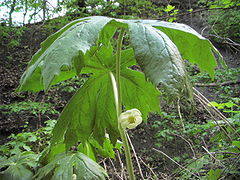- Podophyllum peltatum
-
Mayapple 
Mayapple in flower Scientific classification Kingdom: Plantae Division: Magnoliophyta Class: Magnoliopsida Order: Ranunculales Family: Berberidaceae Genus: Podophyllum Species: P. peltatum Binomial name Podophyllum peltatum
L.Podophyllum peltatum, commonly called mayapple, is a herbaceous perennial plant in the family Berberidaceae, native to wooded areas of eastern North America.[1]
The stems grow to 30-40 cm tall, with 2 or occasionally 3 palmately lobed leaves up to 20-30 cm diameter with 5-9 deeply cut lobes on reproductive individuals, or one peltate (umbrella-like) leaf on sterile individuals. The single secund white flower 3-5 cm diameter, with six (rarely up to nine) petals, is produced at the axil of the two leaves (the upper two in a three-leaved plant); the flower matures into a yellow-greenish fruit 2-5 cm long. The plant is widespread and appears in clonal colonies in open mesic woodlands. Individual shoots are often connected by systems of thick tubers and rhizomes.[2] Plants are commonly found infected by the rust Puccinia podophylli,[1] appearing as honeycomb-patterned orange colonies under the leaves, and yellowish lesions on the upper surface.
Though the common name is mayapple,[3] it is the flower that appears in early May, not the "apple". The fruit or "apple" is produced early summer and ripens later in summer. P. peltatum is also called hogapple, Indian apple, mayflower, umbrella plant (shape of the leaves), wild lemon (flavor of the fruit), wild mandrake, American mandrake (shape of rhizomes) or "devil's apple" (used for Solanum linnaeanum elsewhere).
The rhizome of the mayapple has been used for a variety of medicinal purposes, originally by indigenous inhabitants and later by other settlers.[2]
Contents
Toxicity
The ripened fruit is edible in moderate amounts, though when consumed in large amounts the fruit is poisonous. The rhizome, foliage and roots are also poisonous.[4] Mayapple contains podophyllotoxin,[5] which is used as a cytostatic and topically in the treatment of viral and genital warts.
Gallery
References
- ^ "Podophyllum peltatum". Integrated Taxonomic Information System. http://www.itis.gov/servlet/SingleRpt/SingleRpt?search_topic=TSN&search_value=18850.
- ^ a b Fondren, Brian T. "Mayapple". Ethnobotanical leaflets. http://www.siu.edu/~ebl/leaflets/mayapple.htm. Retrieved 2006-06-03.
- ^ Podophyllum peltatum at USDA PLANTS Database
- ^ Blanchan, Neltje (2002). Wild Flowers: An Aid to Knowledge of our Wild Flowers and their Insect Visitors. Project Gutenberg Literary Archive Foundation.
- ^ Moraes, R.M., H. Lata, E. Bedir, M. Maqbool, and K. Cushman. 2002. On American Mayapple as practical source of podophyllotoxin p. 527–532. In: J. Janick and A. Whipkey (eds.), Trends in new crops and new uses. ASHS Press, Alexandria, VA.
External links
Categories:- Berberidaceae
- Flora of North America
- Native Forbs of Ontario
- Flora of Alabama
- Flora of Maryland
- Medicinal plants
- Poisonous plants
- Fruit
Wikimedia Foundation. 2010.






